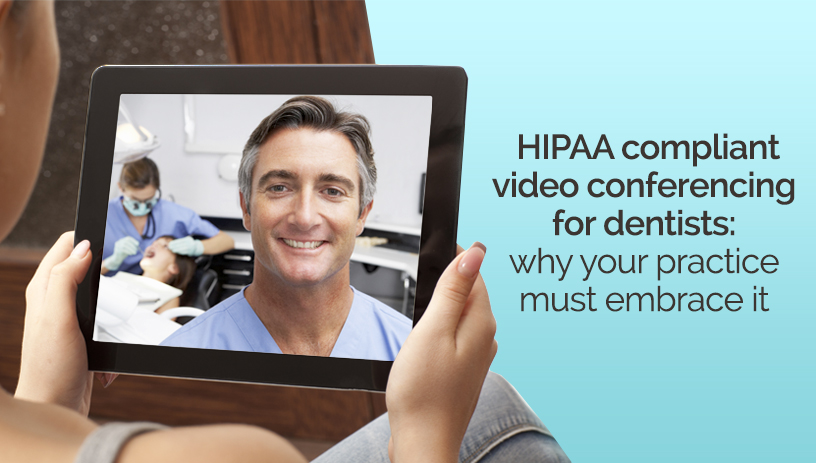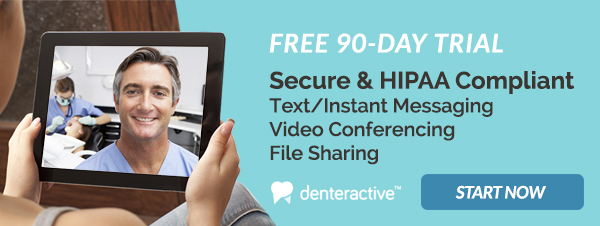HIPAA compliant video conferencing for dentists: why your practice must embrace it

In October of 2014, California became the fourth state to pass a law requiring Medi-Cal to pay for certain types of dental services delivered through teledentistry, extending dentistry services to those who might not normally find their way into a dentist’s office. Several states have followed suit, including most recently, New York. Surely, this will open the door for private insurance companies to extend benefit coverage for TELEDENTISTRY.
The number of dentists currently using video conferencing with their patients is steadily increasing. The exact number is currently unknown as dentists are not required to report what they use, but as of 2011, 7% of US doctors were video chatting with patients.
As of 2015, 64% of patients surveyed were willing to video chat with their doctor.
88% of the patients surveyed said they would choose a doctor based on the ability to teleconference with them.
Sales and service for the product is at an all time high. There are many companies that provide this service, including Skype, but Skype and many others are not compliant with HIPAA.
This isn’t as difficult or foreign as it might sound. You don’t have to be an expert in high tech to do it. The software is easily available and easy to use. Software trends will always continue to change and improve and the trend now is more and more dentists are jumping on board in order to help more patients and continue to increase their assistance, production, and viability.
If this isn’t something you’re currently doing, there are many good reasons to consider making the change. It’s as easy as making a phone call. All smartphones and tablets have the ability to do it and most desktop computers have the necessary camera. All that you would need to do add is HIPAA compliant software, which ours is and is a vital important point.
There are a great many advantages to adopting the ability to video conference with your patients.
- Better communication is the key factor. Nothing replaces personal contact and being able to see your patient, and them being able to see you. This undoubtedly creates an environment of safety and care. You are able to detect subtle changes in the conversation and see things that you would miss on a phone call. These subtle changes tell you much of the state of your patient’s mind and concerns or questions. This gives you more opportunity to delve into what they may be concerned about or have questions on.
- Increased productivity occurs as you’ve taken the time to talk more with your patient and they are more confident in proceeding with the treatment. You have a greater opportunity to educate and help them. This creates a higher level of trust in you and your practice. The more a patient trusts the doctor, the more treatment they will accept and proceed with.
- You are able to extend your patient care from your office into their home or office. This makes it more personal and therefore more valuable to them. You become the one who cared enough to take the time to talk to them face-to-face rather than a hurried phone call or a less effective text message.
- You will have greater access to more patients as they rely more and more on convenience that this service offers. Patients are always looking for the latest technology and this fits in with their quest. We are now into the second generation of people that have grown up with the Internet and they are very comfortable with it and use it extensively. It is important that you and your office also keep up with the latest advances.
- You will be just a click away. You will be providing little to no time wasted in your waiting room. This is crucial to many people. You avoid your patient having to take time off work and their travel time. This decreases the chance of cancellation or no-shows. You can schedule the consultation at your patient’s convenience. They no longer have to rearrange their entire day to come in to talk to you. It gives both of you greater freedom and gives you more opportunity to be of service to them.
- Increased patient retention. Patients are more concerned about the personal touch and care of a doctor more than anything else. Cost isn’t their true objection. Having a doctor or staff that don’t seem to care is the number one concern. When you take the time to show them that you care and are listening, you’ll have a loyal and committed patient base. Retaining patients who refer others is the best way to grow your practice. Patients refer when they are confident that their friends and family will be treated and cared for throughout the entire process.
- Increase your treatment acceptance. Let’s face it – would you be more inclined to buy from someone on the phone or someone who you were having a face-to-face conversation with? Nothing replaces personal contact and this is as close as you can get without them being in your office. Getting patients to accept treatment is made more difficult if you are not aware of what their true obstacles and barriers are. When you are sitting next to them in your operatory, patients will very often agree to treatment and then suddenly forget all about it as they are brought up to the front desk. If you are video conferencing with them, it is as if you are next to them in the chair. You are able to answer their questions and help them make the right decision. Being remote and unseen increases the chances of them refusing treatment. Lessen the chances by being right there with them, virtually, in the operatory.
- Potentially Lowered cost. Virtual introductory visits are substantially cheaper than office visits for both of you. The patient does not lose time from work or incur the cost of paying for gas to get to your office for an initial consultation meeting. And, You will have more time to see the patients in your office and not have to worry about a room being set-up to talk with a dental prospect. Once a successful initial meeting is ascertained and expectations are set, a more comprehensive examination and treatment planning visit can easily be set.
- Your patient doesn’t feel rushed. One of the major complaints patients have about their doctor is that he/she always seems to be rushed. We know you have a busy day and this feature allows you to be in close contact with your patients and show them that you do have enough time for them, that you are listening, and that you care. When they see the value of you taking the time to talk with them and that they have your full attention, they will open up more and you have a better chance of answering their questions and helping them with their concerns and fears.
- Being accessible as a doctor provides good will between you and your patient, along with their family and friends. Knowing they can talk to you privately and without having the hassle of making an appointment instills confidence in you and your practice.
- Increasing the patient’s trust and confidence. The key factors to a patient accepting treatment doesn’t really have much to do with money. It has to do with trust and confidence. People spend money on the things they want and being able to afford them isn’t really part of the equation. We buy what we want. If you have a patient that isn’t going forward with treatment, having a video chat with them can make the difference from them “wanting to think about it” to you being able to talk to them sincerely and uncover what the true barrier is. It is also much easier to get them on the phone with a video chat than to come back to your office.
If you take a moment and think back to the times you were comfortable buying something or being a patron of an establishment, what were the factors that prompted your decision? Were the people pleasant and friendly? Did they make you feel welcomed and important? Did they instill a high level of confidence in their product or service? Did they take the time to answer all your questions and never made you feel rushed?
If you answered “yes” to any or all of the above, then you understand what your patient is looking for. Perhaps you get calls from people who are looking for a dentist. Having a well trained front desk who are also pleasant is a big plus, but how much would your new patient flow increase if you, or your staff, were able to video conference with the prospective new patient? What would happen if a prospective new patient was able to see you and your staff without having to come in for an appointment? With the ease of video chat available on smartphones and tablets, your prospective new patient would be able to do that in a moment.
Remember – we believe more with what we see than what we hear. We trust our eyes more than our ears when it comes to making a decision. Combining a conversation with visual is powerful and has a greater positive effect on all those involved.
Dentists that are using this are reporting an increase in patient satisfaction and confidence. They are more in touch with their patients and quickly building more rapport and trust. The younger generation is very comfortable with this technology and expects it. You can lose potential patients if you are not up-to-date on the latest high tech and that is income you will never know you lost because it never showed up. Patients look for convenience and ease when picking a dentist. The more accessible you and your staff are, the greater your chances of increasing your new patient flow and retention.
“It’s almost as good as being there,” said Dr. Gregory Smith
“I don’t have people knocking on the door and saying, ‘Doc, we need you in another room,’ said Dr. Dan Diamond
“What we use it for, it’s absolutely perfect. It allows us to see patients in an on demand basis. We’ve seen thousands of patients and for our use, it’s as good as gold,” said Dr. John Shufeldt
The Denteractive program is easy to use and offers many features:
- Secure communication that is compliant with HIPAA.
- Video chat
- Secured text messaging and file sharing
- Comprehensive and secure storage of documents.
- Live scheduling and ability to see your calendar for conferencing or appointment setting.
- Patients able to search for dentists via zip code, insurance, or procedures.
- Patients able to speak with you in an emergency.
It is imperative that you use software that is HIPAA compliant.This means that all information regarding your patient and their care abides by the strict law of how the patients information is taken, stored, and forwarded. It includes:
- Physical safeguards within your practice. This refers to workstations and electronic media.
- Technical safeguards that secure only those compliant with HIPAA have access to the patients information.
- Technical policies on how the information is recovered if necessary.
- Network security which covers all methods of transmitting information – email, video conference calls, Internet, and all cloud-based functions.
Denteractive is a HIPAA compliant solution for video chatting with your patients. It can be used on mobile or on desktop and offers a many other smart communication, treatment tracking, and appointment management tools. We are the foremost thought leader on this topic and are committed to the integrity of the dental field. Do not trust your practice and reputation to video services that are not HIPAA compliant. Feel free to contact us anytime. We are dedicated to your practice and the protected privacy of your patients.




